Corn Cob Jelly 2 Ways – Traditional or Less Sugar
Whether it's traditional or low sugar, corn cob jelly adds a unique bit of sweetness to your table. Refrigerate or water bath can for longer storage.

Each year I make up an assortment of jams, jellies, and preserves to give as gifts during the holiday season. I like to include recipes that you can't find at the grocery store, and corn cob jelly fits the bill.
If you've followed the site for a while, you know that I prefer canning recipes that use less sugar. I know some of you are looking for that old fashioned corn cob jelly flavor profile, so I've included both here.
How to Make Corn Cob Jelly
Both recipes start with corn cob juice. You can make this jelly with field corn or sweet corn. I use the corn cobs left over from freezing sweet corn or canning corn.
I did a quick pH test on my corn cob juice, and came up with a pH of around 6 – 6.25. For safe water bath canning, pH should be 4.6 or lower.
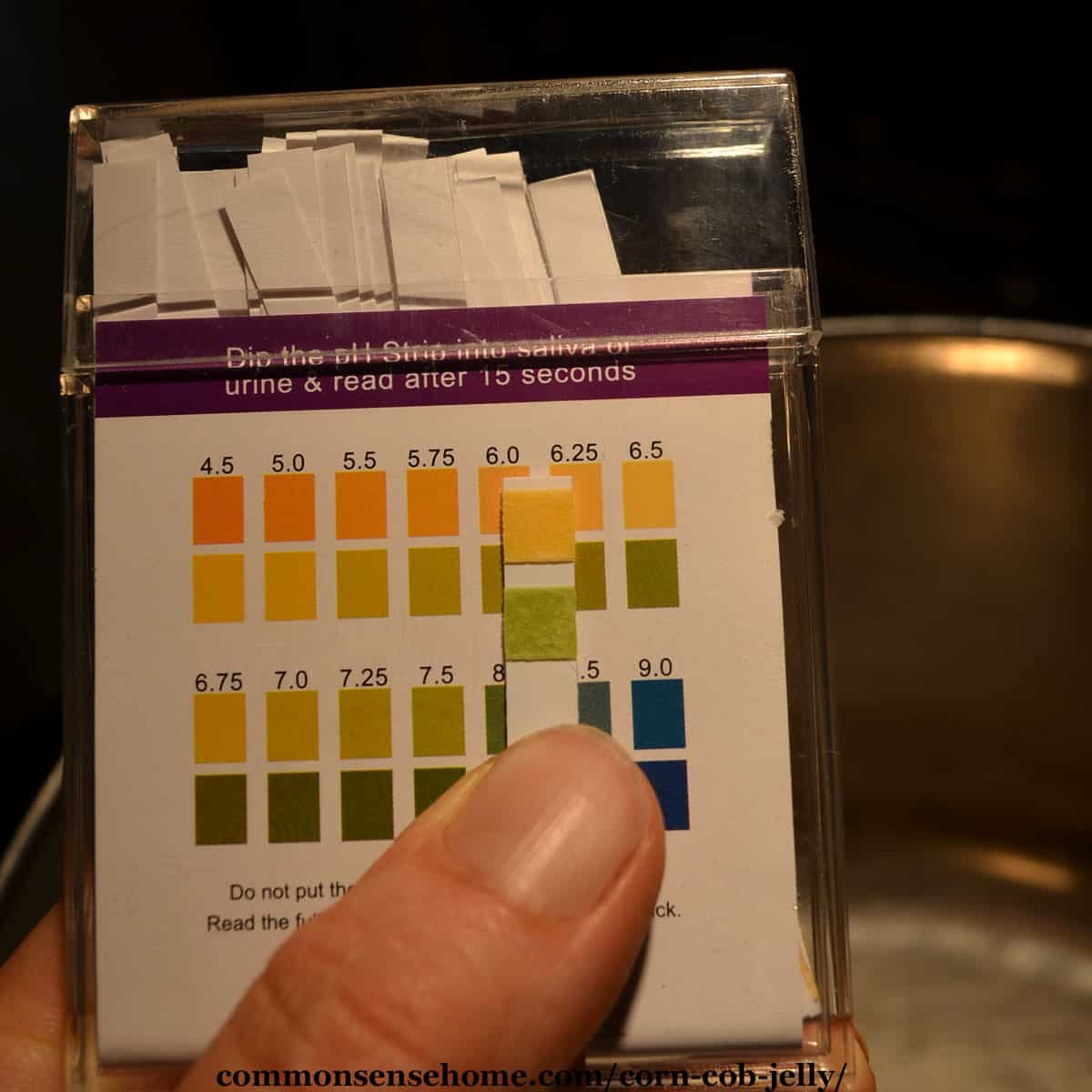
The National Center for Home Food Preservation notes, ” This recipe does produce an acidic jelly as tested.” Sure Jell pectin contains citric acid, so this lowers the pH.
With the high sugar content of old fashioned corn cob jelly, the sugar also protects it from spoilage. With the low sugar version, I add lemon juice to make sure we have a lower pH.
Both jelly recipes are somewhat soft set. If you want a firmer jelly, you can add extra pectin. This is easier to do with Pomona's Pectin (just add an extra teaspoon). For the Sure Jell, you'll need to open another packet, or buy bulk pectin.
Making Corn Cob Juice
To make corn cob juice, you need:
- 1 dozen medium to large fresh corn cobs (remove the kernels from the cobs)
- 2 quarts water
Bust the cobs into chunks. Place the cobs in a large pot, add 2 quarts water or enough to cover, and bring to a boil. Reduce heat and simmer, covered, for 35 to 40 minutes, stirring occasionally.
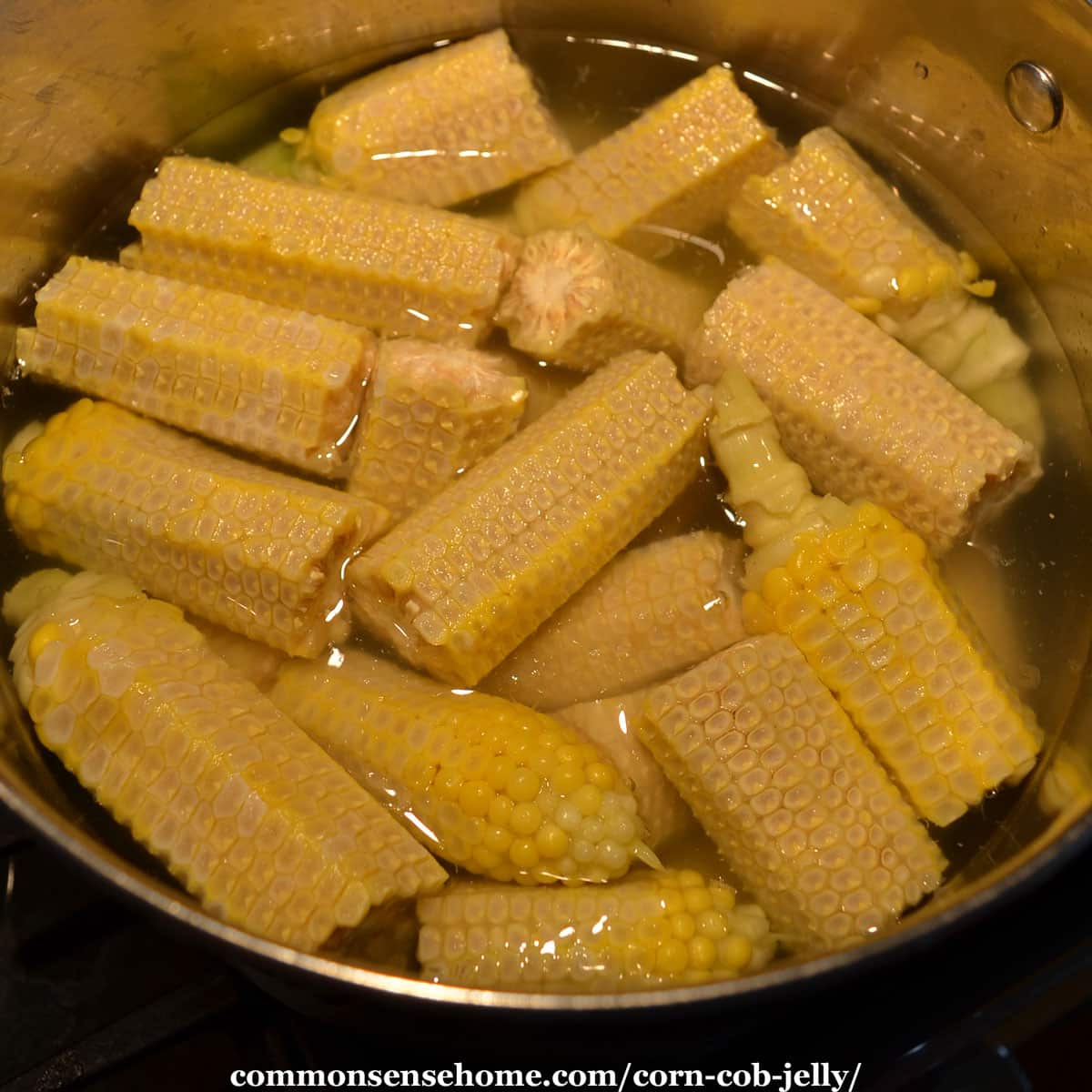
Strain the liquid through cheesecloth, a jelly bag, or flour sack towel. To keep your corn cob jelly clear, don't squeeze the bag or cloth. I like a little more corn flavor, so I go ahead and give it a squeeze.
Making the Corn Cob Jelly (Traditional Full Sugar)
Ingredients:
- 3 cups corn cob juice
- 1 (1¾ ounce) package Sure Jell powdered pectin or other full sugar pectin
- 3 cups sugar
Directions:
Measure 3 cups of corn cob juice into a 6-8 quart stock pot. (Add water if needed to make 3 cups liquid.) (Using a heavy bottom pot helps to prevent scorching.)
Stir in the pectin and bring to a boil.
Add the sugar and bring back to a full rolling boil while stirring constantly. Boil for 5 minutes, stirring frequently.
Your corn cob jelly will bubble up quite a bit, and is likely to form some foam. The foam is normal and edible, it just makes the jelly less clear.
Remove from heat; skim off foam if desired. Pour hot jelly immediately into hot jars, leaving ¼-inch headspace.
Wipe rims of jars with a dampened clean towel. Screw on two-piece metal canning lids until finger tight. Process in a Boiling Water Canner for 10 minutes. (Adjust for altitude if needed.)
Yield: About 4 half-pint jars
Making low sugar corn cob jelly is similar, but you need Pomona's Universal Pectin. Pomona's Pectin uses calcium to gel instead of sugar, so you can make low or even no sugar recipes.
Each box of Pomona's Pectin makes 2-4 recipes. One of our readers said, “CSH turned me on to Pomona pectin and I must say it’s the best tasting batch of strawberry jam I have ever processed!! Thank you.”
We have the print friendly version of both recipes below.
Print Friendly Recipes
PrintCorn Cob Jelly – Traditional Full Sugar
This old fashioned corn cob jelly recipe tastes like sweetened corn or honey. Enjoy it on toast, pancakes, waffles or however you like your jams and jellies.
- Prep Time: 5 minutes
- Simmer time: 35 minutes
- Cook Time: 15 minutes
- Total Time: 55 minutes
- Yield: 4 cups 1x
- Category: jelly
Ingredients
- 1 dozen medium to large fresh corn cobs (remove the kernels from the cobs)
- 2 quarts water
- 1 (1 3/4 ounce) package Sure Jell powdered pectin or other full sugar pectin
- 3 cups sugar
Instructions
To make corn cob juice, bust the cobs into chunks. Place the cobs in a large pot, add 2 quarts water or enough to cover, and bring to a boil. Reduce heat and simmer, covered, for 35 to 40 minutes, stirring occasionally.
Strain the liquid through cheesecloth, a jelly bag, or flour sack towel. To keep your corn cob jelly clear, don't squeeze the bag or cloth. I like a little more corn flavor, so I go ahead and give it a squeeze.
Measure 3 cups of corn cob juice into a 6-8 quart stock pot. (Add water if needed to make 3 cups liquid.) (Using a heavy bottom pot helps to prevent scorching.)
Stir in the pectin and bring to a boil.
Add the sugar and bring back to a full rolling boil while stirring constantly. Boil for 5 minutes, stirring frequently.
Your corn cob jelly will bubble up quite a bit, and is likely to form some foam. The foam is normal and edible, it just makes the jelly less clear.
Remove from heat; skim off foam if desired. Pour hot jelly immediately into hot jars, leaving ¼-inch headspace.
Wipe rims of jars with a dampened clean towel. Screw on two-piece metal canning lids until finger tight. Process in a Boiling Water Canner for 10 minutes. (Adjust for altitude if needed.)
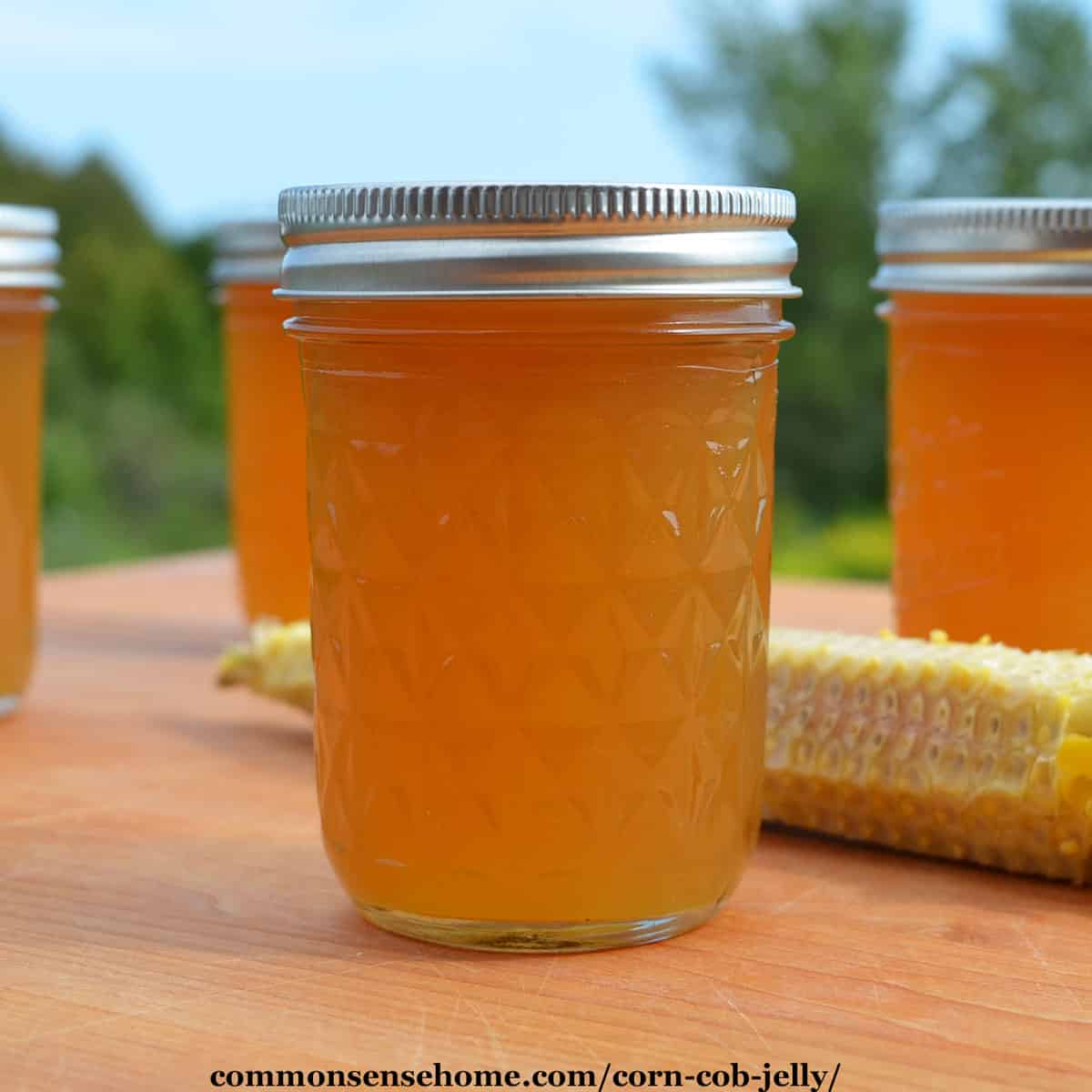
Corn Cob Jelly – Less Sugar
This less sweet version of corn cob jelly let's the mellow sweetness of the corn come through, complemented by a hint of lemon.
- Prep Time: 5 minutes
- Simmer time: 35 minutes
- Cook Time: 15 minutes
- Total Time: 55 minutes
- Yield: 4 cups 1x
- Category: jelly
Ingredients
- 1 dozen medium to large fresh corn cobs (remove the kernels from the cobs)
- 2 quarts water
- 4 teaspoons calcium water (include in the box of Pomona's Pectin)
- 1/4 cup lemon juice
- 4 teaspoons Pomona's Pectin
- 2 cups sugar
Instructions
To make corn cob juice, bust the cobs into chunks. Place the cobs in a large pot, add 2 quarts water or enough to cover, and bring to a boil. Reduce heat and simmer, covered, for 35 to 40 minutes, stirring occasionally.
Strain the liquid through cheesecloth, a jelly bag, or flour sack towel. To keep your corn cob jelly clear, don't squeeze the bag or cloth. I like a little more corn flavor, so I go ahead and give it a squeeze.
Measure 4 cups of corn cob juice into a 6-8 quart stock pot. (Add water if needed to make 4 cups liquid.) (Using a heavy bottom pot helps to prevent scorching.)
Stir in the calcium water and lemon juice and bring to a boil.While the juice mix is heating, stir together the pectin powder and sugar.
Add the sugar/pectin mix and bring back to a full rolling boil while stirring constantly. Boil for 2 minutes, stirring frequently.
Your corn cob jelly will bubble up quite a bit, and is likely to form some foam. The foam is normal and edible, it just makes the jelly less clear.
Remove from heat; skim off foam if desired. Pour hot jelly immediately into hot jars, leaving ¼-inch headspace.
Wipe rims of jars with a dampened clean towel. Screw on two-piece metal canning lids until finger tight. Process in a Boiling Water Canner for 10 minutes. (Adjust for altitude if needed.)
Notes
What is calcium water?
Each box of Pomona's Pectin comes with two packets. One packet is pectin, the other packet is calcium powder.
Before you start your jam, jelly, or preserves, you mix 1/2 teaspoon of calcium powder with 1/2 cup of water. This is your calcium water, and you can use one batch of calcium water to make many batches of fruit. I love that I get several batches of preserves out of one box of pectin.
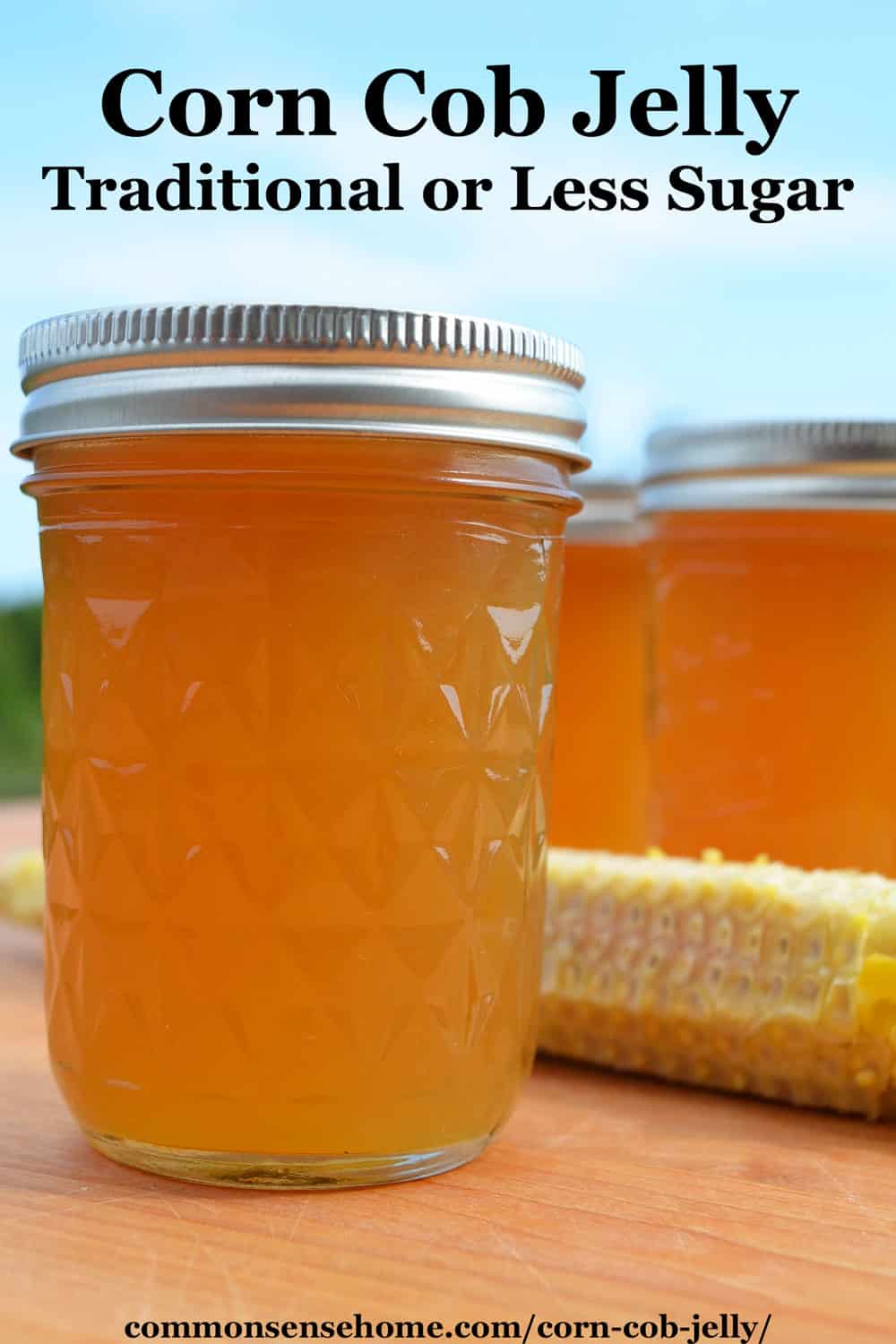
More Jam and Jelly Recipes
We have dozens of recipes for jams, jellies, spreads, and preserves on the site. You can find them on the Recipes Index Page, or get them in ebook format with your purchase of my bread book.
The recipes include:
- Brandied Cinnamon Apple Preserves
- Dandelion Jelly
- Cherry Preserves – Chocolate Cherry and Cherry Vanilla
- Strawberry Rhubarb Jam
- Blushing Peach Jam
…and many more!


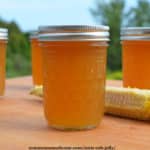
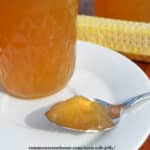
The folks at Pomona Pectin have researched this, and determined that it is not a safe recipe. They suggest freezing, or refrigerating and eating within a couple weeks.
https://pomonapectin.com/developing-your-own-recipes-for-cooked-jam-or-jelly-using-pomonas/
I understand their concern, but I did test the pH of the finished product, and it was within safe canning guidelines (4.6 or lower). The recipe that they said was unsafe only had 1 tablespoon of lemon juice, which would not be enough. I had no issues with this jelly keeping in storage for a year.
To double check pH levels, you can get pH strips or a pH meter. They did not make and test the jam (at least they hadn’t at the time of the comment), and only provided their “best guess’ version.
Can I use regular sure jell with no sugar needed?
I haven’t checked the cooking instructions on that brand recently. I’m sure you can use it, but you might need to tweak the cooking method a bit. Try to find a similar recipe on the package insert (some sort of jelly using a fruit that’s low in pectin) and use those cooking instructions.
Can you save the corn cob juice in the refrigerator or freeze and use at a later date!
I wouldn’t try to hold it long in the refrigerator, but overnight would be okay. If you freeze it, it should hold for several months.
How in the world did you get 4 half pints? I did exactly as the recipe said and got exactly 3.
Maybe you cooked it a little long? You start with 4 1/4 cup of liquid, and then add 2 cups of sugar, so if you only got three cups, you lost over a cup of liquid somehow.